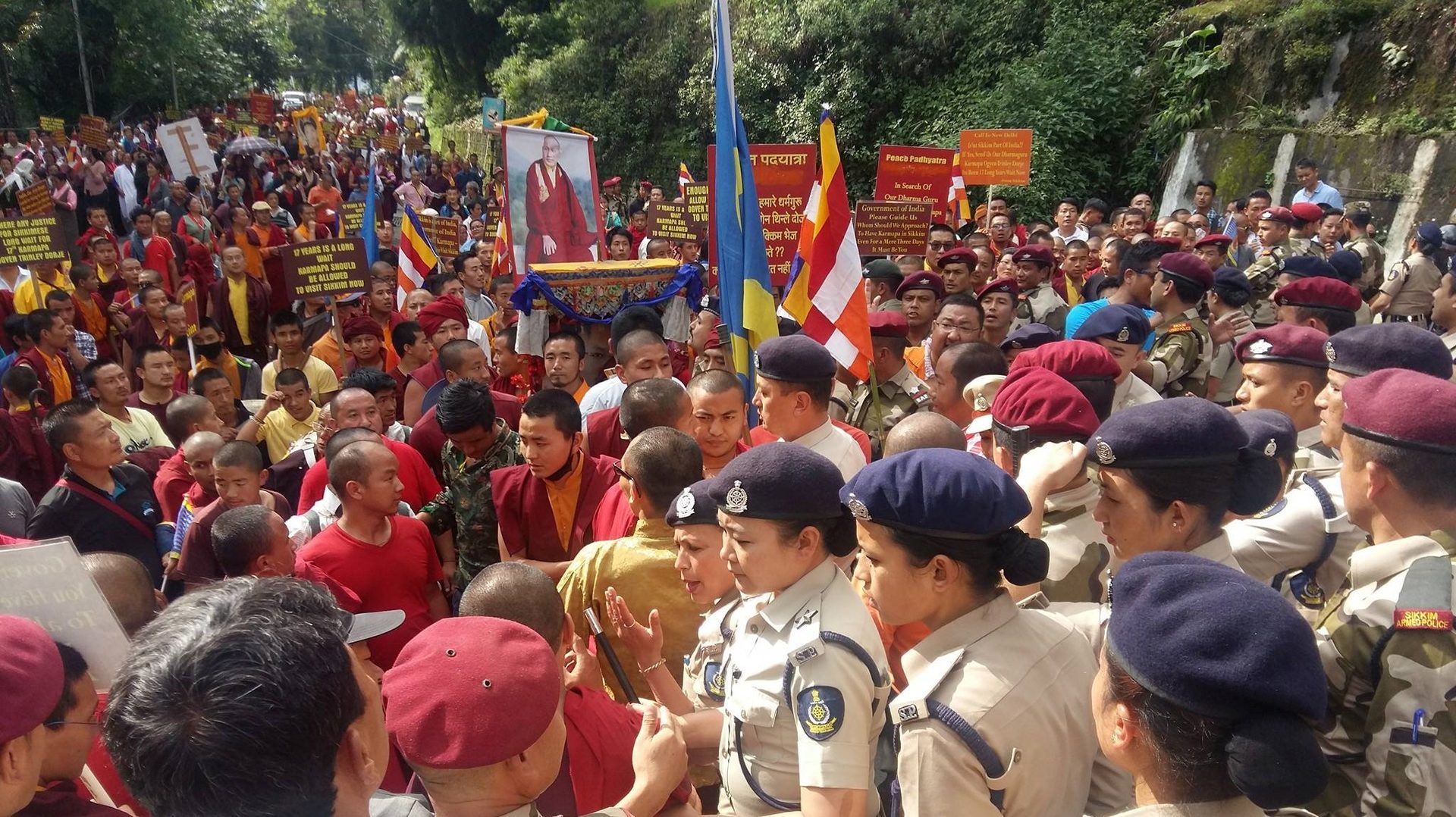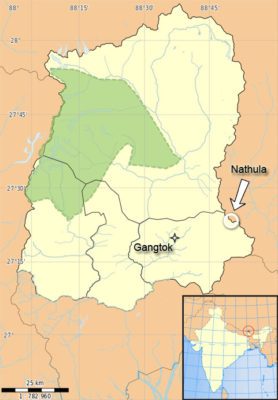
Sikkim’s geo-strategic value is twofold: firstly and most well-documented is the exchange facilitated by the historical trans-Himalayan road between India and Tibet. However before going into more detail on this, it is necessary understand the much less documented but also very important fact that Sikkim has been a medium of exchange in the Great Game of U.S. geopolitics.
In the 1970s, the U.S. wanted to lure Russia into the Afghan trap. To do so, they furbished the Taliban with weapons and mercenaries, recruited mainly by Pakistan and Saudi Arabia, which had been made possible by the extraordinary 400% increase in the price of oil in 1973. Due to the vital target at stake via Pakistan, it was absolutely essential for the U.S. to neutralise both China and India. It was at this point when Secretary of State Henry Kissinger re-opened diplomatic ties with China. Simultaneously, efforts were made by America to pacify Indira Gandhi’s government during the time she wished to bring Aksai Chin back within Indian borders, and hence to keep India out of the region. This resulted in Henry Kissenger’s visit to India in October 1974 and the diplomatic push by the Americans to divert Indian attention towards the annexation of Sikkim, instead of opening a new front in an area where they needed to remain undisturbed by side issues. This remarkable geo-strategic play is explained by the former U.S. ambassador in to India, Daniel Patrick Moynihan, in Andrew Duff’s “Sikkim: Requiem for a Himalayan Kingdom”.
Trans-Himalayan trade between Tibet and its southern neighbours, particularly India, has taken place since ancient times. One of the main trade routes was through Sikkim to Kalimpong, the largest entrepôt of Indo-Tibetan trade, which was annexed from Bhutan by the British Raj in 1865. It was the interest of the British to secure a vertical corridor, which they achieved after the 1888 Sikkim-Tibet border expedition. A trade route was constructed from Kalimpong to the Nathu La pass on the Sikkimese frontier with Tibet. Afterwards, half of the trade between Tibet and India passed thorough this road, making Sikkim a strategic economic and military corridor to bridge the Himalayas between India and Tibet. Due to this route, the British could organise the 1903-04 Younghusband expedition to Tibet, which first settled in Gangtok, the capital of the Sikkimese Kingdom.
What the British accomplished from south to north paved the way for China from north to south. Sikkim now represents a highly strategic corridor for any ground campaign. Should the region develop closer allegiance with China, this may facilitate China’s capacity to restrict the bottleneck of military supply constituted by the India-Nepal border in the north and the India-Bangladesh border in the south to only a few kilometres of distance. The narrow 24 km strip of land known as the “Chicken’s Neck” or Siliguri Corridor (named after the major city in the area) separates India from its northeast states and would be the only overland route for Indian military forces to reach the contested territory of Arunachal Pradesh, should China make a new incursion.
From the Chinese point of view, it is crystal clear that Sikkim should fall under its influence, of course peacefully, via its new soft power tools, primarily its control of Buddhist clerics. This is confirmed by the extreme caution with which the Indian secret service dealt with Karmapa Ogyen Trinley Dorje, head of the influential Kagyu sect, who was understood to be under the influence of the Chinese government. For the entire 17 years he resided in India (2000-17) he was forbidden from Sikkim, particularly the seat of his predecessor who was based there.
Although China and India agreed on the opening of trading posts at Nathu La on the Sikkim-Tibet border (the first ever Sino-Indian joint declaration, signed in 2003) some experts have argued that it is naïve for the Indian side to assume that due to this, China’s influence on Sikkim would diminish. Also, while the joint declaration was initially expected to include precise formulations on the status of Sikkim and Tibet, India’s acknowledgement of Tibet as part of China was not matched by an explicit Chinese recognition of Sikkim as part of India. A closer examination of the Chinese side of this frontier post reveals that long prior to the Nathu La agreement China had been constructing an all-weather expressway up to the border, as well as permanent trading huts, customs buildings and check posts. China’s plans to extend the Golmud-Lhasa Railway to Yadong, just across the border from Nathu La, will also facilitate the movement of military goods and personnel as well as rail-mobile missiles.
On the other side, it is a fact that Sikkim’s former Chief Ministers Pawan Chamling and Nar Bahadur Bhandari have expressed views in line with Chinese interests. For instance Bhandari actively supported the efforts to install in Sikkim the above-mentioned Karmapa Ogyen Trinley Dorje, appointed (and never dismissed) by the Chinese authorities (although, also recognised by the Dalai Lama). In this elaborate Asian double game of strategies and tactics, it is a fact that Bhandari received cash payment from China through a high-ranking Taiwanese minister, Chen Li-an (a prominent supporter of Taiwan’s reunification with mainland China) in connection with his support for the installation. The ensuing scandal led to investigations against Bhandari by the Indian Central Government which contributed to his ousting and replacement, briefly by Sanchaman Limboo, and then Chamling, who became Chief Minister in 1994. Some years later, Bhandari was eventually jailed for graft.
Chamling secured re-election for five successive terms, creating modern political history in India and retaining power longer than even many of Sikkim’s former "Chogyals" (kings). He consolidated his position and proceeded to develop ever warmer ties with the Chinese authorities in Tibet. While proving no less corrupt than his predecessor, he was far more efficient in his ability to pull the country’s strings of power. It was a situation that the Chinese government appreciated, and it was certainly not by chance that Chamling’s aims were in line with their interests. Not only from the perspective of the above-mentioned religious soft power, but also strategically by promoting Chinese access to the Chicken’s Neck under the guise of facilitating trade. In actuality, the great promise of trade through Nathula has not been realised. Since its opening in 2006, nothing significant has developed. In terms of the military, China has continued to encroach on the northern border. Contrary to its promise, India’s armed forces have not yet developed a sufficient military presence to counterbalance the danger of a Chinese incursion towards the Siliguri Corridor.
With Chamling being replaced in 2019 by Prem Singh Tamang (aka Golay) of the Sikkim Krantikari Morcha ("Sikkim Revolutionary Front"), time will tell Sikkim will continue to degenerate into a “second Nepal” with its attendant political turmoil. Unfortunately the signs of unrest haven’t shown a peaceful direction, with the not-so-subtly veiled threats to the Central Government that Sikkim will re-assert independence if the Chinese appointed Karmapa Ogyen Trinley Dorje continues to be prevented from entering Sikkim. While permission was eventually granted in 2018, it was only after he had permanently fled from India.

Siliguri Corridor, India's "Chicken's Neck"
The Siliguri corridor, aka the “Chicken’s Neck”, is one of India’s greatest strategic anxieties. It is a cartographic remnant of the process of British decolonisation and subsequent partition. When the modern states of India and Pakistan (East and West) were established along religious lines, an attempt was made to maintain contiguity between Bengal and Assam. The creation of East Pakistan (later Bangladesh) necessitated this choke point. At its narrowest point, the Siliguri corridor has a distance of only 22 km between the borders of Bangladesh and Nepal.
Ever since the Sino-Indian war of 1962, a scenario has been anticipated in which Chinese forces may attempt to block the vulnerable Siliguri corridor and cut off India’s north-east. In 1975, India’s fortunes were slightly ameliorated through its annexation of Sikkim.
In acknowledgement of its importance to national security, the the Indian state’s forces maintain a heavy presence in the Siliguri region. The Indian Army, the Assam Rifles, the Border Security Force, and the West Bengal Police all patrol the region. India’s Research and Analysis Wing (R&AW) closely observes any activity by Nepalese, Bhutanese, and Bangladeshis in the region. Among other issues, the Siliguri corridor has been vulnerable to illegal Bangladeshi immigration into India. There is also speculation that Pakistan’s Inter-Services Intelligence (ISI) has activated Nepali insurgents in attempts to exploit the region.
The extent to which the threat of Chinese intervention is serious has been demonstrated since 1996 when China began a concerted diplomatic effort to yield a border claim with Bhutan in exchange for the Doklam Plateau. Such a territorial swap with would place the key to India’s choke point in China’s hands.

Map of Sikkim showing the Nathlu La pass
Nathu La is a mountain pass connecting the Sikkim with Tibet. The pass forms part of an offshoot of the ancient Silk Road. Nathu means “listening ears” and La means “pass” in Tibetan. On the Indian side, the pass is 54 km east of Gangtok, the capital of Sikkim.
Nathu La is one of the two open trading border posts between China and India (the other being Shipkila in Himachal Pradesh). Sealed after the 1962 war, Nathu La was re-opened in 2006 following numerous bilateral trade agreements. As well as its hoped-for role in Sino-Indian trade, the opening also shortens the travel distance to important Hindu and Buddhist pilgrimage sites in the region.
It is also one of the four officially agreed BPM (Border Personnel Meeting) points between the Indian Army and People’s Liberation Army of China for regular consultations and interactions between the two armies, which helps in defusing face-offs. The four BPM are: Chushul in Ladakh, Nathu La in Sikkim, Bum La pass in Tawang district of Arunachal Pradesh, and Lipulekh pass in Uttarakhand.
Sikkim: Requiem for a Himalayan Kingdom, Andrew Duff (2018)
Flight of Karmapa, security of South Asia,Taipei Times (2000-04-05)
Behind China's Sikkim aggression, a plan to isolate Northeast from rest of India, Economic Times (2018-07-12)